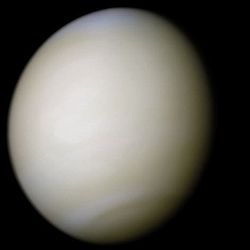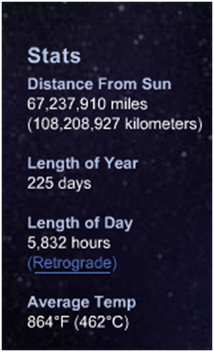Our Solar System
Planet Venus

Venus is the second planet from the Sun, and is Earth's closest neighbor in the solar system. Venus is the brightest object in the sky after the Sun and the Moon, and sometimes looks like a bright star in the morning or evening sky. The planet is a little smaller than Earth, and is similar to Earth inside. We can't see the surface of Venus from Earth, because it is covered with thick clouds. However, space missions to Venus have shown us that its surface is covered with craters, volcanoes, mountains, and big lava plains. The surface of Venus is not where you'd like to be, with temperatures that can melt lead, an atmosphere so thick it would crush you, and clouds of sulfuric acid that smell like rotten eggs to top it off!
The atmosphere of Venus is very hot and thick. You would not survive a visit to the surface of the planet - you couldn't breathe the air, you would be crushed by the enormous weight of the atmosphere, and you would burn up in surface temperatures high enough to melt lead.
The atmosphere of Venus is made up mainly of carbon dioxide, and thick clouds of sulfuric acid completely cover the planet. The atmosphere traps the small amount of energy from the sun that does reach the surface along with the heat the planet itself releases. This greenhouse effect has made the surface and lower atmosphere of Venus one of the hottest places in the solar system! Why should Venus and not the Earth have a hot and thick atmosphere? Some scientists call it the Goldilocks phenomenon.
Venus' atmosphere consists mainly of carbon dioxide, with clouds of sulfuric acid droplets. Only trace amounts of water have been detected in the atmosphere. The thick atmosphere traps the sun's heat, resulting in surface temperatures higher than 880 degrees Fahrenheit (471 degrees Celsius). Probes that have landed on Venus survived only a few hours before being destroyed by the incredible temperatures. Sulfur compounds are abundant in Venus' clouds. The corrosive chemistry and dense, moving atmosphere cause significant surface weathering and erosion.
As Venus moves forward in its solar orbit while slowly rotating backwards on its axis, the top level of cloud layers zips around the planet every four Earth days, driven by hurricane-force winds traveling at about 360 km (224 miles) per hour. The wind speeds within the clouds decrease with cloud height, and winds at the surface are estimated to be just a few kilometers per hour. How this atmospheric super-rotation forms and is maintained continues to be a topic of scientific investigation.
Atmospheric lightning bursts, long suspected by scientists, were finally confirmed in 2007 by the European Venus Express orbiter. On Earth, Jupiter and Saturn, lightning is associated with water clouds, but on Venus, it is associated with clouds of sulfuric acid.
The atmosphere of Venus is very hot and thick. You would not survive a visit to the surface of the planet - you couldn't breathe the air, you would be crushed by the enormous weight of the atmosphere, and you would burn up in surface temperatures high enough to melt lead.
The atmosphere of Venus is made up mainly of carbon dioxide, and thick clouds of sulfuric acid completely cover the planet. The atmosphere traps the small amount of energy from the sun that does reach the surface along with the heat the planet itself releases. This greenhouse effect has made the surface and lower atmosphere of Venus one of the hottest places in the solar system! Why should Venus and not the Earth have a hot and thick atmosphere? Some scientists call it the Goldilocks phenomenon.
Venus' atmosphere consists mainly of carbon dioxide, with clouds of sulfuric acid droplets. Only trace amounts of water have been detected in the atmosphere. The thick atmosphere traps the sun's heat, resulting in surface temperatures higher than 880 degrees Fahrenheit (471 degrees Celsius). Probes that have landed on Venus survived only a few hours before being destroyed by the incredible temperatures. Sulfur compounds are abundant in Venus' clouds. The corrosive chemistry and dense, moving atmosphere cause significant surface weathering and erosion.
As Venus moves forward in its solar orbit while slowly rotating backwards on its axis, the top level of cloud layers zips around the planet every four Earth days, driven by hurricane-force winds traveling at about 360 km (224 miles) per hour. The wind speeds within the clouds decrease with cloud height, and winds at the surface are estimated to be just a few kilometers per hour. How this atmospheric super-rotation forms and is maintained continues to be a topic of scientific investigation.
Atmospheric lightning bursts, long suspected by scientists, were finally confirmed in 2007 by the European Venus Express orbiter. On Earth, Jupiter and Saturn, lightning is associated with water clouds, but on Venus, it is associated with clouds of sulfuric acid.

